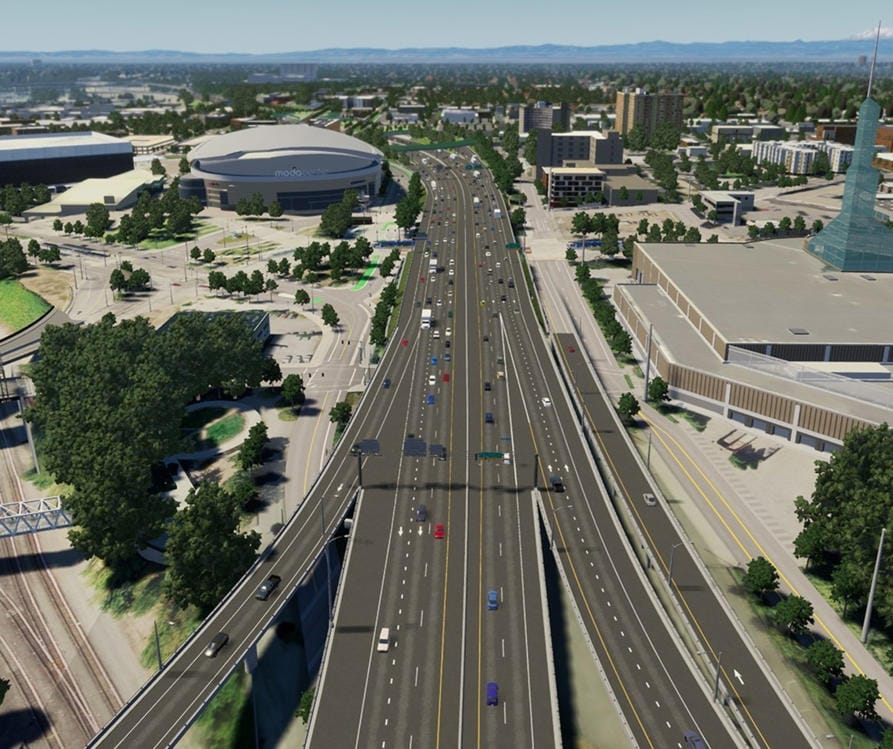New estimates peg the cost to add auxiliary lanes on Interstate 5 near Portland’s Rose Quarter and build other improvements at $715 million to $795 million.
That’s nearly a 60 percent increase over previous estimates of $450 million to $500 million.
The higher estimates, first reported by Willamette Week last month, are part of a “Cost to Complete” report released Tuesday night.
According to the Oregon Department of Transportation, inflation accounts for nearly half of the cost increases. Initial estimates were based on 2017 dollars. New estimates have been adjusted to reflect 2025 dollars, the assumed midpoint of construction. Other factors driving up costs are better estimates for right-of-way acquisition, preliminary engineering and actual construction.
Regardless of their cause, the higher costs are the latest setback for a project that has attracted a large group of opponents. They include No More Freeway Expansions and others who question how adding freeway capacity won’t increase greenhouse gas emissions and argue that ODOT should prepare a full environmental impact statement.
ODOT maintains that the project would simply add auxiliary lanes between onramps and offramps to ease congestion and improve safety without building additional lanes to move more through traffic.
“This is a mature corridor,” said April deLeon-Galloway, ODOT’s community engagement coordinator for the Rose Quarter project. “We are not developing new destinations.”
Clark County
The project, if it is built, could be a benefit for Clark County commuters who can get jammed by daily congestion near the Rose Quarter, the nation’s 28th biggest truck bottleneck.
The project also has implications for the second effort getting underway to replace the Interstate 5 Bridge. Critics of bridge replacement say it doesn’t make sense to ease chronic congestion near the Columbia River if nothing is done about a major traffic chokepoint some 5 miles farther south.
Fierce opposition to the Rose Quarter project could provide a preview of upcoming debate over replacing the I-5 Bridge and what that project means for climate change and residential development in Clark County.
Gov. Jay Inslee, who made climate change the centerpiece of his short-lived presidential campaign last year, is a strong supporter of replacing the I-5 Bridge. Inslee, in a telephone interview with The Columbian last week, referenced the potential for the I-5 Bridge to collapse in an earthquake when asked how he reconciles his support for the project with his views on climate change.
“I’m convinced there will be a heck of a lot more carbon pollution from old clunker fuel-powered ferry boats going across the Columbia when the bridge falls down the next time the earth shakes a little bit,” he said.
Critics of the I-5 Bridge project dispute that the twins spans represent an unacceptable seismic risk.
Inslee also said he believes the increasing popularity of electric vehicles will tamp down on greenhouse gas emissions.
“If you envision electric cars, electric buses, someday electric trucks and light rail across the bridge, I think we have a way to actually reduce dramatically the carbon footprint of using that right of way,” he said.
22 percent reduction
ODOT officials say they studied greenhouse gases for the Rose Quarter project using Federal Highway Administration guidelines and an Environmental Protection Agency vehicle emission simulator model. They concluded there wasn’t a significant difference between the build and no-build options evaluated in the project’s February 2019 environmental assessment.
That assessment predicted that greenhouse gas actually would decline by 22 percent during the next 25 years, primarily due to more stringent fuel standards and lower-carbon fuels. Project benefits — higher travel speeds, less stop-and-go traffic and reduced vehicle idling — also would contribute to the reduction.
ODOT still has received pushback, including from elected officials with Metro, the city of Portland and Multnomah County. That prompted Oregon Gov. Kate Brown to ask the Oregon Transportation Commission to temporarily pause the project.
In her Dec. 16 letter to the transportation commission, Brown pointed out that building more freeway capacity could induce demand, or encourage more people to drive.
“We cannot build our way out of congestion by inducing greater demand on the system,” she wrote. “We must manage demand to reduce congestion while also reducing emissions consistent with our state’s greenhouse gas emissions goal.”
“I also agree we can’t build our way out of congestion,” said Megan Channell, major projects manager for ODOT in Multnomah, Clackamas, Hood River and the eastern half of Washington County. “But this project is so much more.”
The section of I-5 between Interstate 84 and Interstate 405, at the north end of the Fremont Bridge, is congested for 12 hours a day and has a crash rate 3.5 times higher than Oregon’s statewide average.
“They call us the Portland stoplight,” Channell said. “We have to address the issues in this area, and we can do that through auxiliary lanes.”
Project benefits
The Rose Quarter project would:
• Add auxiliary lanes in both directions along a 1.7-mile section of I-5.
• Build freeway caps over two sections to structurally upgrade existing overpasses and create public space.
• Construct local street improvements, including a new pedestrian-bicycle bridge over the freeway from Clackamas Street to the Rose Quarter.
ODOT officials say the Rose Quarter project would reduce crashes by 50 percent, save 2.5 million hours of traffic delay each year, and provide wider freeway shoulders for vehicle breakdowns, fender-bender crashes and emergency response.
Portland Public Schools has been keeping a close eye on the project because Harriet Tubman Middle School is adjacent to the freeway’s east side. Scott Bailey, a Portland School Board member, told the Oregon Transportation Commission last month that his district would oppose the project unless ODOT completes a full environmental impact statement.
Tuesday’s report estimates that would add another three years and $66.3 million to $86.4 million in costs to the project.
The Oregon Legislature, when it approved a transportation bill in 2017, agreed to provide $30 million a year in gas-tax revenue to the project starting in 2022. The revised cost estimates leave ODOT with a funding gap it would need to fill prior to the projected 2023 construction start.




